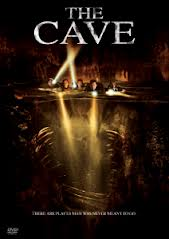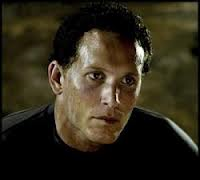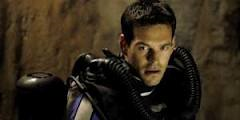BENEATH HEAVEN LIES HELL. BENEATH HELL LIES…
The Cave. Actually, I probably could’ve designated this claustrophobic 2005 horror flick as a Guilty Pleasure, even though I’ve always enjoyed watching it. Not so others, apparently. Research revealed that it barely broke  even at the box office worldwide, and it was disliked—in some cases reviled—by critics and the public alike. Ah well, as I once said about taste: I don’t have much. I just know what I like, and there are far worse ways of spending the film’s ninety-seven minutes of run time.
even at the box office worldwide, and it was disliked—in some cases reviled—by critics and the public alike. Ah well, as I once said about taste: I don’t have much. I just know what I like, and there are far worse ways of spending the film’s ninety-seven minutes of run time.
The serviceable cast has no A-listers, but quite a few familiar faces, including Cole Hauser (Pitch Black), Eddie Cibrian (tons of TV work), Piper Perabo (Coyote Ugly), and Morris Chestnut (Anacondas: The Hunt for the Blood Orchid). The story begins in the 1970s in Romania’s Carpathian Mountains, where some explorers have found a centuries-old church. They’ve also come across the entrance to a subterranean cave system, and when they try to blast their way in, they become trapped. One of the guys has a blatantly distinctive tattoo on his arm. (This is a key plot point.) Off they trudge into one of the tunnels, looking for a way out. They hear these weird sounds ahead, and…

Jack (Cole Hauser) is starting to get weird…
Fade to thirty years later, where archaeologists and biologists are digging through the same ruins and find the same cave system, which contains a vast underground river. They also discover wall images of knights doing battle with winged demons. Hmm. The lead biologist believes that a new ecosystem could exist in the cave, so he hires a team of professional spelunkers, all decked out in the latest hi-tech diving gear, to lead the expedition. The team includes the aforementioned quartet. All told, nine people descend a mile into the cave. As you can guess, there won’t be nine folks reaching the surface vertically by movie’s end.
The body count begins to mount early, and often. We get minimal glimpses of the creatures at first. The dive team leader, Jack (Cole Hauser) is infected by one of the things and begins to “change” as the story progresses. Soon there are few left, and the creatures—winged, screechy lizard-things—have revealed themselves. One of the biologists posits that parasites in the cave take over other life forms. Oh, ya think? As one of the team is dragged off, we see a tattoo on the monster’s appendage: yep, it’s the guy from thirty years ago, now mutated.

Pick a tunnel, dude, any tunnel…
Anyway, I won’t spoil the ending, in case you’re so compelled to immediately put this movie atop your Netflix queue. Suffice to say that the last twenty minutes or so move at breakneck speed to a conclusion, and there is, of course, the hint of a sequel—which never happened. Another film, The Descent, came out the same year, with a similar plot, and this one made a load of money, got fairly okay reviews, and even spawned a sequel. (I have to admit, I’ve never seen it, but it’s now on my list.) Perhaps The Cave suffered by comparison. Whatever; for claustrophobic horror it is worth checking out. Enjoy!
TOLKIEN: THE GOLD ATOP THE MOUNTAIN

John Ronald Reuel Tolkien
The quest of Frodo Baggins and the Fellowship in J.R.R. Tolkien’s Lord of the Rings wasn’t about riches but rather power—and the survival of multiple races, of course. Not so The Hobbit, where Bilbo and Gandalf join with a bunch of dwarves to take back their treasure from Smaug, the dragon. I’m sure this treasure was worth quite a bit in modern-day Earth’s dollars or pounds. But could Tolkien, who died in 1973, even begin to imagine what the products of his vivid imagination would be worth some four decades later? I doubt it.
Recently I received a note from Emily Stewart of the Online MBA website. Emily and her team have put together a video that illustrates some of the entertainment and economic impacts of Tolkien’s most renowned stories. The brief video (under two minutes) is titled, The Economic Impact of Lord of the Rings, and it is quite an eye opener. Check it out.

Hey Mike,
It’s been a while, but I’ve seen both “The Cave” and “The Descent” all the way through once, with bits and pieces on other occasions. Personally, I don’t see much of a difference in the quality of the stories and would place both squarely in the realm of “guilty pleasures”. Maybe “The Descent” got more attention because it was primarily about women in that sort of situation?? But, if you like the feeling of underground claustrophobia, then these movies would fill the bill. Along the same lines there is “Sanctum”, which I thought sucked (not even a guilty pleasure), especially for the money invested in making it.
On a different note, I did watch the video on the economic impact of LOTR. It is indeed amazing how much money it has generated. What I find even more amazing, however, is the number of people one person can touch with a book…even long after they are gone. That thought is humbling, indeed.
(As a point of interest: I watched other videos there, as well, and was blown away by the talent of the woman who illustrated the points being discussed. It’s worth it just to watch her!)
You’re right, I was quite impressed by the video in more ways than just the information about how folks are getting rich from Tolkien’s imagination. 🙂